The floods are the most fatal environmental disaster in the country’s modern history. Over 2,300 people have died and over 10,000 are still missing as a result of the devastation caused by the Mediterranean storm Daniel in Libya, according to The Associated Press. The eastern city of Derna has been most impacted; according to officials, up to 25% of the city has been completely destroyed. “I am not exaggerating when I say that 25 per cent of the city has disappeared,” one government official told Reuters. Let’s take a closer look. Also read: Storm Daniel sweeps Libya, over 2000 people feared dead Libya floods The Mediterranean-based storm unleashed its wrath on a nation that was already in danger of collapsing due to a long-running dispute. Two dams and four bridges collapsed in Derna, submerging much of the city when Storm Daniel hit on Sunday, reported CNN. [caption id=“attachment_13117662” align=“alignnone” width=“640”]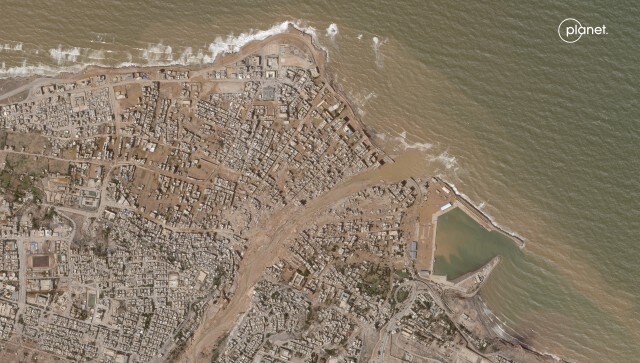 This satellite photo from Planet Labs PBC shows flooding in Derna, Libya, on Tuesday. AP[/caption] As per AP, videos of the aftermath show water gushing through the port city’s remaining tower blocks and overturned cars, and later, bodies lined up on sidewalks covered with blankets, collected for burial. Residents say the only indication of danger was the loud sound of the dams cracking, with no warning system or evacuation plan. Buildings have been destroyed, dams have broken, and there has been tremendous devastation in a number of eastern Libyan cities, including Al-Marj Tobruk, Takenis, Al-Bayada, Battah, and all the way up the eastern coast to Benghazi. [caption id=“attachment_13117732” align=“alignnone” width=“640”]
This satellite photo from Planet Labs PBC shows flooding in Derna, Libya, on Tuesday. AP[/caption] As per AP, videos of the aftermath show water gushing through the port city’s remaining tower blocks and overturned cars, and later, bodies lined up on sidewalks covered with blankets, collected for burial. Residents say the only indication of danger was the loud sound of the dams cracking, with no warning system or evacuation plan. Buildings have been destroyed, dams have broken, and there has been tremendous devastation in a number of eastern Libyan cities, including Al-Marj Tobruk, Takenis, Al-Bayada, Battah, and all the way up the eastern coast to Benghazi. [caption id=“attachment_13117732” align=“alignnone” width=“640”]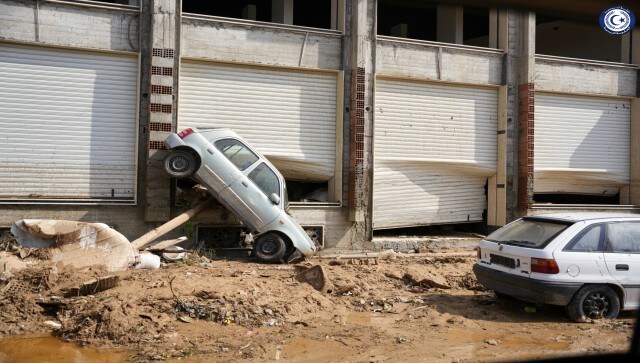 In this photo provided by the Libyan government, a car sits suspended against a shop front after being carried by floodwaters in Derna, Libya. AP[/caption] Osama Aly, head of Libya’s Emergency and Ambulance Authority, told CNN that homes in valleys were completely destroyed by strong muddy currents bringing automobiles and debris. He added phone lines in the city are also down. There are terrifying tales of people drowning at sea while others clung to rooftops for dear life. Many bodies were believed trapped under rubble or had been washed out into the Mediterranean Sea, said eastern Libya’s health minister, Othman Abduljaleel. “We were stunned by the amount of destruction … the tragedy is very significant, and beyond the capacity of Derna and the government,” Abduljaleel told AP on the phone from Derna.
In this photo provided by the Libyan government, a car sits suspended against a shop front after being carried by floodwaters in Derna, Libya. AP[/caption] Osama Aly, head of Libya’s Emergency and Ambulance Authority, told CNN that homes in valleys were completely destroyed by strong muddy currents bringing automobiles and debris. He added phone lines in the city are also down. There are terrifying tales of people drowning at sea while others clung to rooftops for dear life. Many bodies were believed trapped under rubble or had been washed out into the Mediterranean Sea, said eastern Libya’s health minister, Othman Abduljaleel. “We were stunned by the amount of destruction … the tragedy is very significant, and beyond the capacity of Derna and the government,” Abduljaleel told AP on the phone from Derna.
The rich hills of the Jabal Akhdar region surround Derna, which is located around 250 km east of Benghazi along the coast. [caption id=“attachment_13117752” align=“alignnone” width=“640”]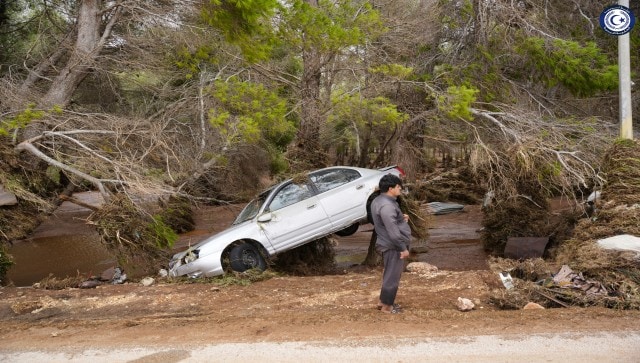 In this photo provided by the Libyan government, a car sits partly suspended in trees after being carried by floodwaters in Derna, Libya. AP[/caption] The reason it is so devastating This week’s disastrous flooding in Greece was caused by a highly potent low-pressure system that went into the Mediterranean before intensifying into a tropical storm known as a medicane, according to CNN. The rain that has washed across multiple cities in Libya’s north-east is the result of this medicane. Notably, the catastrophic storm occurs during a year that has witnessed a record number of climate disasters and extreme weather conditions, including destructive wildfires and unprecedented heat. The Mediterranean Sea’s temperature is significantly higher than typical, which, according to scientists, contributed to the storm’s torrential rainfall, as ocean temperatures worldwide rise out of control as a result of pollution that contributes to global warming. [caption id=“attachment_13117682” align=“alignnone” width=“640”]
In this photo provided by the Libyan government, a car sits partly suspended in trees after being carried by floodwaters in Derna, Libya. AP[/caption] The reason it is so devastating This week’s disastrous flooding in Greece was caused by a highly potent low-pressure system that went into the Mediterranean before intensifying into a tropical storm known as a medicane, according to CNN. The rain that has washed across multiple cities in Libya’s north-east is the result of this medicane. Notably, the catastrophic storm occurs during a year that has witnessed a record number of climate disasters and extreme weather conditions, including destructive wildfires and unprecedented heat. The Mediterranean Sea’s temperature is significantly higher than typical, which, according to scientists, contributed to the storm’s torrential rainfall, as ocean temperatures worldwide rise out of control as a result of pollution that contributes to global warming. [caption id=“attachment_13117682” align=“alignnone” width=“640”]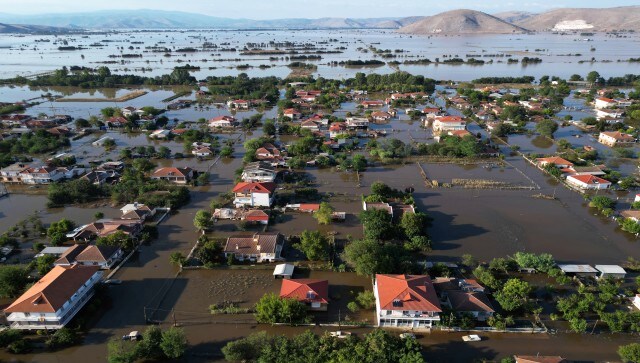 Floodwaters and mud cover the town of Palamas, after the country’s rainstorm record, in Karditsa, Thessaly region, central Greece. AP[/caption] “The warmer water does not only fuel those storms in terms of rainfall intensity, it also makes them more ferocious,” Karsten Haustein, climate scientist and meteorologist at Leipzig University in Germany, told the Science Media Center. Also read: Explained: How climate change is threatening the future of wildlife Lack of single government Analysts say that Derna’s infrastructure, particularly the ruptured dams, was already in a terrible situation and that this contributed to the havoc that the storm inflicted. Its infrastructure is in disarray and was exposed to heavy rains as a result of years of prolonged conflict and the absence of a central government. According to the United Nations, Libya is now the only nation that has not yet created a national climate plan. [caption id=“attachment_13117702” align=“alignnone” width=“640”]
Floodwaters and mud cover the town of Palamas, after the country’s rainstorm record, in Karditsa, Thessaly region, central Greece. AP[/caption] “The warmer water does not only fuel those storms in terms of rainfall intensity, it also makes them more ferocious,” Karsten Haustein, climate scientist and meteorologist at Leipzig University in Germany, told the Science Media Center. Also read: Explained: How climate change is threatening the future of wildlife Lack of single government Analysts say that Derna’s infrastructure, particularly the ruptured dams, was already in a terrible situation and that this contributed to the havoc that the storm inflicted. Its infrastructure is in disarray and was exposed to heavy rains as a result of years of prolonged conflict and the absence of a central government. According to the United Nations, Libya is now the only nation that has not yet created a national climate plan. [caption id=“attachment_13117702” align=“alignnone” width=“640”]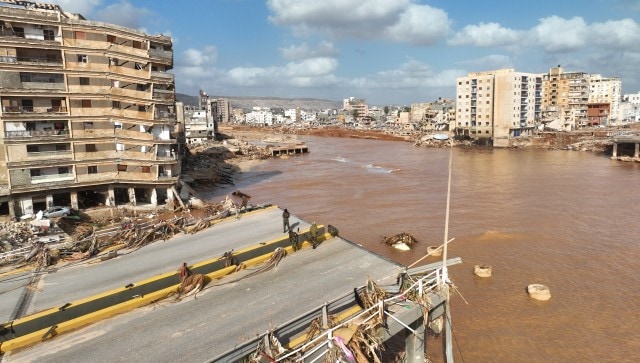 Mediterranean storm Daniel caused devastating floods in Libya that broke dams and swept away entire neighbourhoods in multiple coastal towns, the destruction appeared greatest in Derna city. AP[/caption] Since the 2011 Arab Spring rebellion, which was supported by NATO, that destroyed Moammar Gaddafi’s dictatorial regime, the nation of North Africa has been split into competing governments and plagued by militia conflict. In Tripoli, Prime Minister Abdul Hamid Dbeibah heads Libya’s internationally recognized government. In Benghazi, the rival prime minister, Ossama Hamad, heads the eastern administration, which is backed by powerful military commander Khalifa Hiftar, according to AP. Both governments and the eastern commander have separately pledged to help the rescue efforts in the flood-affected areas, but they have no record of successful cooperation.
Mediterranean storm Daniel caused devastating floods in Libya that broke dams and swept away entire neighbourhoods in multiple coastal towns, the destruction appeared greatest in Derna city. AP[/caption] Since the 2011 Arab Spring rebellion, which was supported by NATO, that destroyed Moammar Gaddafi’s dictatorial regime, the nation of North Africa has been split into competing governments and plagued by militia conflict. In Tripoli, Prime Minister Abdul Hamid Dbeibah heads Libya’s internationally recognized government. In Benghazi, the rival prime minister, Ossama Hamad, heads the eastern administration, which is backed by powerful military commander Khalifa Hiftar, according to AP. Both governments and the eastern commander have separately pledged to help the rescue efforts in the flood-affected areas, but they have no record of successful cooperation.
Despite international pressure and scheduled elections that were never held in 2021, rival parliaments have refused to unite for years. A tale of a neglected city Much of Derna was constructed when Libya was under Italian occupation in the first half of the 20th century. It became famous for its scenic white beachfront houses and palm gardens. But in the aftermath of Gaddafi’s ouster in 2011, it disintegrated into a hub for Islamist extremist groups, was bombarded by Egyptian airstrikes and later besieged by forces loyal to Hiftar. The city was taken by Hiftar’s forces in 2019. [caption id=“attachment_13117782” align=“alignnone” width=“640”]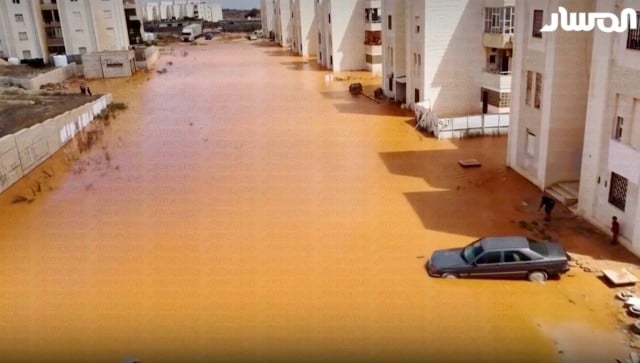 Streets are flooded after being hit by storm Daniel in Marj, Libya. AP[/caption] Like other cities in the east of the country, it has not seen much rebuilding or investment since the revolution. Most of its modern infrastructure was constructed during the Gaddafi era, including the toppled Wadi Derna dam, built by a Yugoslav company in the mid-1970s. According to Jalel Harchaoui, an associate fellow specializing in Libya at the London-based Royal United Services Institute for Defence and Security Studies, Hiftar views the city and its population with suspicion and has been reluctant to allow it too much independence. Last year, for instance, a massive reconstruction plan for the city was led by outsiders from Benghazi and elsewhere, not natives of Derna. “Tragically, this mistrust might prove calamitous during the upcoming post-disaster period,” Harchaoui said. Also read: Explained: Underground climate change, the silent hazard causing cities to sink Numerous challenges Libya, like many less developed nations, was not prepared for Daniel’s catastrophic weather. According to a report from the Libyan News Agency (LANA), the situation in Libya is “unprecedented.” Hamad, the head of the eastern administration. “It is important to recognise that the storm itself is not just the single cause of the loss of life,” said Dr Kevin Collins, a senior lecturer on environment and systems at the Open University told The Guardian, adding, “It is also partly a function of Libya’s limited ability to forecast weather impacts; limited warning and evacuation systems; and planning and design standards for infrastructure and cities. As our climate changes, understanding, planning for and adapting to these more extreme types of events needs to be done by individuals, businesses, and communities in all countries.” The complicated political landscape of the nation “poses challenges for developing risk communication and hazard assessment strategies, coordinating rescue operations, and also potentially for maintenance of critical infrastructure such as dams,” Leslie Mabon, another lecturer at the university, told the Science Media Centre. [caption id=“attachment_13117802” align=“alignnone” width=“640”]
Streets are flooded after being hit by storm Daniel in Marj, Libya. AP[/caption] Like other cities in the east of the country, it has not seen much rebuilding or investment since the revolution. Most of its modern infrastructure was constructed during the Gaddafi era, including the toppled Wadi Derna dam, built by a Yugoslav company in the mid-1970s. According to Jalel Harchaoui, an associate fellow specializing in Libya at the London-based Royal United Services Institute for Defence and Security Studies, Hiftar views the city and its population with suspicion and has been reluctant to allow it too much independence. Last year, for instance, a massive reconstruction plan for the city was led by outsiders from Benghazi and elsewhere, not natives of Derna. “Tragically, this mistrust might prove calamitous during the upcoming post-disaster period,” Harchaoui said. Also read: Explained: Underground climate change, the silent hazard causing cities to sink Numerous challenges Libya, like many less developed nations, was not prepared for Daniel’s catastrophic weather. According to a report from the Libyan News Agency (LANA), the situation in Libya is “unprecedented.” Hamad, the head of the eastern administration. “It is important to recognise that the storm itself is not just the single cause of the loss of life,” said Dr Kevin Collins, a senior lecturer on environment and systems at the Open University told The Guardian, adding, “It is also partly a function of Libya’s limited ability to forecast weather impacts; limited warning and evacuation systems; and planning and design standards for infrastructure and cities. As our climate changes, understanding, planning for and adapting to these more extreme types of events needs to be done by individuals, businesses, and communities in all countries.” The complicated political landscape of the nation “poses challenges for developing risk communication and hazard assessment strategies, coordinating rescue operations, and also potentially for maintenance of critical infrastructure such as dams,” Leslie Mabon, another lecturer at the university, told the Science Media Centre. [caption id=“attachment_13117802” align=“alignnone” width=“640”]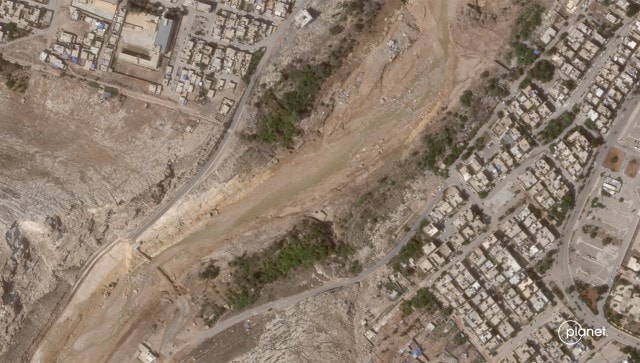 This satellite photo from Planet Labs PBC shows a dam collapse in Derna, Libya, on Tuesday. AP[/caption] “We expect the intensity of heavy rainfall to increase as the world warms,” said Prof. Lizzie Kendon, professor of climate science at the University of Bristol Cabot Institute for the Environment. This won’t manifest as a smooth trend, and we should prepare for the occurrence of extraordinary events that haven’t been observed before. “Storm Daniel is illustrative of the type of devastating flooding event we may expect increasingly in the future, but such events can occur just due to the natural variability of the climate – as they did in the past. Therefore, care is needed before linking any specific extreme event to climate change.” Also read: 79 dead and hundreds missing: What to know about the deadly boat disaster in Greece International aid The Tripoli government, which is not in charge of the eastern regions, has sent help to Derna despite the political division between the East and West. On Tuesday, according to India Today, a relief flight from Misrata, a city in western Libya also departed to the affected region. In-country rescue operations are being aided by the UAE, Egypt, and Turkey. Rescue efforts were having trouble getting to Derna as of Tuesday, though. Claudia Gazzini, a senior Libya analyst at International Crisis Group, says the problem is partially logistical with many of the roads entering the port city having been severed by the storm. “International efforts to send rescue teams have to go through the Tripoli-based government,” Gazzini told AP. This means that authorization to allow help inside the areas that are most affected must be approved by competing authorities. She was skeptical the Benghazi government could manage the problem alone, she said. With inputs from agencies
This satellite photo from Planet Labs PBC shows a dam collapse in Derna, Libya, on Tuesday. AP[/caption] “We expect the intensity of heavy rainfall to increase as the world warms,” said Prof. Lizzie Kendon, professor of climate science at the University of Bristol Cabot Institute for the Environment. This won’t manifest as a smooth trend, and we should prepare for the occurrence of extraordinary events that haven’t been observed before. “Storm Daniel is illustrative of the type of devastating flooding event we may expect increasingly in the future, but such events can occur just due to the natural variability of the climate – as they did in the past. Therefore, care is needed before linking any specific extreme event to climate change.” Also read: 79 dead and hundreds missing: What to know about the deadly boat disaster in Greece International aid The Tripoli government, which is not in charge of the eastern regions, has sent help to Derna despite the political division between the East and West. On Tuesday, according to India Today, a relief flight from Misrata, a city in western Libya also departed to the affected region. In-country rescue operations are being aided by the UAE, Egypt, and Turkey. Rescue efforts were having trouble getting to Derna as of Tuesday, though. Claudia Gazzini, a senior Libya analyst at International Crisis Group, says the problem is partially logistical with many of the roads entering the port city having been severed by the storm. “International efforts to send rescue teams have to go through the Tripoli-based government,” Gazzini told AP. This means that authorization to allow help inside the areas that are most affected must be approved by competing authorities. She was skeptical the Benghazi government could manage the problem alone, she said. With inputs from agencies
)